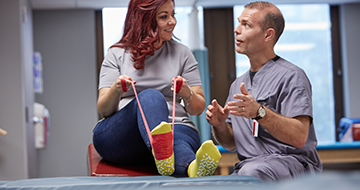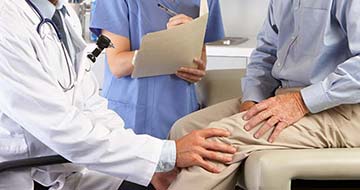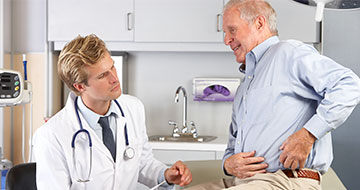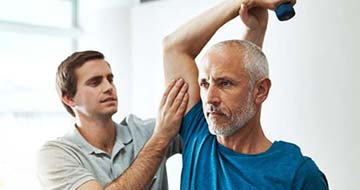Orthopedics
Learn more about your pain by checking out our ortho resources so we can also recommend the best treatment options.
Get back on your feet with a variety of non-surgical and surgical options for your chronic knee pain.
Explore options for relief from your hip pain, including whether partial or total replacement is right for you.
Helping to restore function in your knees, hips or other joints so arthritis doesn’t limit your daily activities. ...
Helping you get back on the playing field with treatment for a wide variety of sports injuries.
Improve your bone health and avoid osteoporosis. Our experienced physicians are here to create a custom care plan ...
Orthopedic Services
Find an Orthopedic Specialist
What to Expect After Knee Surgery
Data from the American Academy of Orthopedic Surgeons (AAOS) states that 90% of people who have knee replacement experience significant pain reduction. Therefore, it’s safe to say that you may live a more active, efficient and more comfortable life after going through knee surgery.
If your doctor recommends knee surgery or you’re waiting to have your procedure, this article can help manage your expectations and give you more information about taking care of your “new” knee.
Hospital Stay and Discharge
You may stay at the hospital for one to four days, depending on the nature of your knee surgery (e.g., total knee replacement or partial knee replacement, minimally invasive or traditional). The length of your stay may also depend on the speed of your recovery. Your doctor may declare your discharge once you accomplish the following:
- Get in and out of bed on your own
- Eat, drink and use the bathroom
- Experience tolerable levels of pain
- Perform recommended home exercises
- Understand knee precautions advised for proper healing and to prevent injuries
- Walk with an assistive device if prescribed any (e.g., cane, crutch or walker) and be able to climb up and down two to three stairs
Note: Your doctor may also transfer you to a rehabilitation or skilled nursing center if, after several days, it is not safe for you to go home. Meanwhile, if you have outpatient knee surgery, you may go home the same day of the surgery.
Recovering After Knee Surgery
You may need assistance at home for several days to a few weeks while recovering. If you don’t have a family member or a friend who can be with you upon discharge, we recommend hiring a caregiver or a physical therapist.
Swelling
It’s normal to experience moderate to severe swelling in the early stages of your recovery. You may also experience mild to moderate swelling for about three to six months after the surgery. Applying ice, slightly elevating your leg or wearing compression stockings can also help reduce swelling.
Please inform your doctor if you notice warning signs of a blood clot which may include:
- Increased swelling of the foot, ankle or calf
- Pain in the calf or leg that is not related to the incision
- Redness or tenderness below or above the treated knee
A blood clot may also go to the lungs and become life-threatening. Please call 911 or go to the nearest emergency room if you experience the following:
- Chest pain with coughing
- Shortness of breath
- Sudden chest pain
Wound Care
Here are some guidelines that can help you take care of your surgical wound and prevent infection:
- Change the wound dressing as often as directed by the orthopedic doctor. Follow the instructions given, and keep the wound clean and dry at all times.
- Ask your doctor when you can take a bath. You may need to wait for a few days after the surgery.
Inform your doctor immediately if you experience warning signs of infection, which may include:
- Chills
- Drainage of the wound
- Fever
- Increased pain when moving and at rest
- Increased redness, swelling or tenderness of the wound
Medication, Supplements and Diet
Your doctor may prescribe antibiotics (to prevent infection), opioid and non-opioid pain killers, anti-nausea medications, stool softeners and oral or injectable blood thinners. Please take each of your medicines as prescribed.
Your provider may recommend supplements or foods that are rich in iron or vitamin K. It is also best that you maintain a healthy weight to avoid putting additional stress on your joints.
Resuming Physical Activities
Your doctor may recommend home exercises that can help you gradually get back to doing your normal activities. Here’s a list of the most common physical activities and when you may be able to do them safely.
- Returning to work – it may take several days to a few weeks before you can safely return to work, depending on the day-to-day physical demands of your job.
- Driving – you may be allowed to resume driving when you are no longer taking opioid pain pills.
- Sexual activity – you may resume sexual activity within a few weeks after surgery, although it may still depend on your condition. Please consult your doctor.
- Sports – please ask your doctor’s clearance before trying or going back to a specific sport. Low-impact sports such as swimming may require less recovery time as compared to high-intensity sports such as football.
Final Thoughts
Every year, about 600,000 people in the United States have knee surgery. Response to surgery varies, and each person heals differently, so talk with your doctor about recovery concerns and going back to your normal activities. Again, if you experience life-threatening symptoms of a blood clot, such as chest pain and shortness of breath, please call 911 or go to the nearest emergency room immediately.
Sources:
OrthoInfo
Healthline








